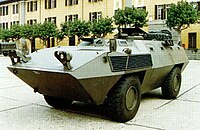
Photo from wikipedia
The violent water entry of flat plates is investigated using a Riemann-arbitrary Eulerian-Lagrangian (ALE) smoothed particle hydrodynamics (SPH) model. The test conditions are of interest for problems related to aircraft… Click to show full abstract
The violent water entry of flat plates is investigated using a Riemann-arbitrary Eulerian-Lagrangian (ALE) smoothed particle hydrodynamics (SPH) model. The test conditions are of interest for problems related to aircraft and helicopter emergency landing in water. Three main parameters are considered: the horizontal velocity, the approach angle (i.e., vertical to horizontal velocity ratio) and the pitch angle, α. Regarding the latter, small angles are considered in this study. As described in the theoretical work by Zhao and Faltinsen (1993), for small α a very thin, high-speed jet of water is formed, and the time-spatial gradients of the pressure field are extremely high. These test conditions are very challenging for numerical solvers. In the present study an enhanced SPH model is firstly tested on a purely vertical impact with deadrise angle α = 4°. An in-depth validation against analytical solutions and experimental results is carried out, highlighting the several critical aspects of the numerical modelling of this kind of flow, especially when pressure peaks are to be captured. A discussion on the main difficulties when comparing to model scale experiments is also provided. Then, the more realistic case of a plate with both horizontal and vertical velocity components is discussed and compared to ditching experiments recently carried out at CNR-INSEAN. In the latter case both 2-D and 3-D simulations are considered and the importance of 3-D effects on the pressure peak is discussed for α = 4° and α = 10°.
Journal Title: Journal of Hydrodynamics
Year Published: 2018
Link to full text (if available)
Share on Social Media: Sign Up to like & get
recommendations!